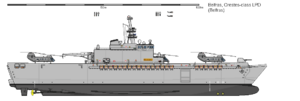Orestes

| |
| Class overview | |
|---|---|
| Name: | Orestes-class amphibious transport dock |
| Builders: | Patmos Shipbuilders Consortium |
| Operators: |
list error: <br /> list (help) |
| Cost: | $300 million |
| In commission: | 1986-present |
| Completed: | 8 |
| Active: | 8 |
| General characteristics | |
| Type: | Amphibious transport dock (LPD) |
| Displacement: | 8,350 t full load |
| Length: | 133.2 m |
| Beam: | 20.75 |
| Draft: | 5.85 m |
| Propulsion: |
2 x Diesel engines 4 x Diesel-turbine generators |
| Speed: | 21 kn |
| Range: | 7,650 nm |
| Boats & landing craft carried: |
list error: <br /> list (help) |
| Capacity: | 350 men w/ 30 medium tanks |
| Complement: | 17 officers, 160 enlisted |
| Sensors and processing systems: | RN/SPQ-42 Search Radar |
| Armament: | 1 x 76mm Super-Rapid cannon |
The Orestes class Amphibious transport dock (LPD) is a class of amphibious warfare vessels originally built for service with the Republic Navy but have since gone on to international usage. The class was designed to function as a cheap-to-use troop transportation platform with options for helicopter and water-craft usage. The class features a bow visor to allow for deployment of personnel and equipment directly onto a beach with assistance of carried landing barges.
Design
The Orestes class was designed to provide a three angle capability to the Navy and Army: It can provide roll-on / roll-off (RO/RO) capability for land embarkation, air lift through helicopters on the flight deck and transportation by sea to shore using a stern water-gate.
The ship's primary function is to conduct RO/RO landings onto beaches using it's bow visor. The ship lines up with the beach and anchors itself into position using bow anchors and stern winches which are dropped with weights to the ocean bottom. Landing barges are retrieved either from the stern water-gate area or from the side of the ship and manoeuvred to the front. The barges are then fastened to eachother to create a make-shift pier from the ship to the beach. The vessel then closes it's stern gate and floods ballast tanks to sink the stern enough to lift the bow by small angle, at which point the secure fastens to the bow visor are undone and the visor is lifted. The inner pressure door is also released before a gangway is lowered onto the barges. This method of landing is expedited with practice and can deliver the entire ship's cargo onto the beach directly.
The class can lift 350 men when carried with 30 medium tanks or 36 tracked armoured vehicles, but can interchange this to carry up to 600 men with vehicles carried on the flight deck without any flight capabilities.
By default the ship carries three LCVP landing craft on port-side davits and can carry three LCM in it's stern dock, which when not in use is covered up by a heavy-duty floor panel to allow for more cargo to be carried. When the panel is closed landing barges can still be carried, with the ones lower in the stack 'flooded' to sink to the bottom of the dock to allow for more to be carried.
The mission profile of the class can be changed quickly, with the ship being outfitted for roles in typical RO/RO transportation, dedicated helicopter carrier duties with the vehicle garage capable of holding medium-lift helicopters and even roles such as a floating hospital if needed.